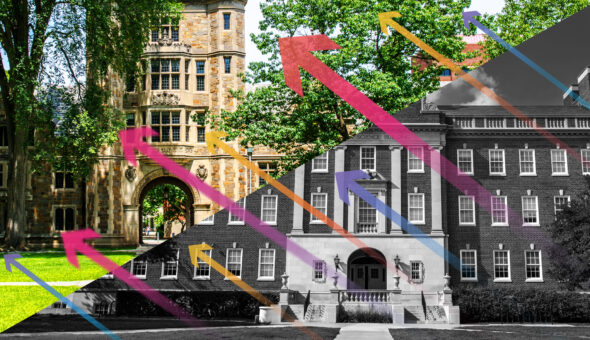This isn’t the setup for a stand-up bit, but it’s going to sound like it: What do a four-day workweek and the enrollment cliff have in common?
Research shows that one may help the other. In this case, a four-day workweek for students—no classes on Friday is how that usually works—can be celebrated as a marketing differentiator when recruiting the lingering members of Gen Z and the up-and-coming members of Generation Alpha.
So, what do a four-day workweek and the struggle to hire and retain great talent have in common?
That same research shows that people are more productive and happier when they work 32 hours versus 40 hours a week. This could be the thing that makes someone decide to accept that job, no matter where the role is on campus.
Since 2020, the idea of what “work” is has changed. A four-day workweek is part of that change
It’s not really four days a week of “work.” It’s more about the hours that an employee is expected to perform the tasks they’re being paid to do during a seven-day period.
Traditionally, a full-time job has been 9 a.m. to 5 p.m. Monday through Friday; eight hours a day for five days, hence 40 hours. That’s the classic model.
“At this point, it’s only inertia holding us back from changing the 9-to-5, five-days-a-week program. It’s time to consider other options,” Jack Kelly wrote in 2021.
How long workers are legally allowed to be on the clock has changed a few times since the industrial revolution laid the track for our modern world. The US government established the 40-hour workweek in 1940.
The story of how this came about is full of labor disputes, unionizing and no-holds-barred capitalism. “With days off, people would have more time for leisure activities and shopping, spending their earnings,” is how Firmspace describes the decision by (problematic) tycoon Henry Ford to set a 40-hour workweek for employees. This would soon become the standard throughout the world of business.
All of this is to say that the 40-hour workweek was, like all things, just made up one day and enough people thought it was a good enough idea that it became the way things are. The status quo. And there’s nothing higher education loves more than a good status quo.
“A college job, once seen as a meaningful and benefits-rich way to earn a paycheck—possibly for a career—isn’t what it once was.” A 2022 report, commissioned by the Chronicle of Higher Education and conducted by Huron, outlined this issue, which is running parallel to the enrollment cliff. Prospective employees are also losing interest in starting a career in higher education. This means leadership, staff and faculty.
A four-day workweek could be one of the ways institutions recruit great talent. Some schools have already tried it, found it to work and are continuing with the program.
“We absolutely feel it’s going to help us with talent acquisition,” Lorrie Clemo, president of D’Youville, told Inside Higher Ed. “We feel very strongly it will also help us with employee attrition.”
It’s the same arguments that drove the decision to codify the 40-hour workweek in the first place: work-life balance, employee mental health and increased productivity.
To reverse enrollment trends, colleges … need new strategies to attract populations they have long undervalued and underserved: working adults.
The key in these switches as they happen in already established workplaces is the idea that an employee is paid the same amount as they would be for 40 hours of work, but they are now expected to work 32 hours. Keeping the pay and benefits the same and reducing the number of “working” hours is what is appealing to employees. It has proven successful in large trials.
There is no question that implementing this on a campus that has a 24/7 lifestyle will take months of planning and conversation, if not longer. The story linked above about D’Youville’s move toward the 32-hour workweek describes the training and professional development workshops necessary to ensure student services are not impacted.
It’s not as simple as saying we no longer have to come in on Fridays. A lot of planning and rethinking would go into any campus embracing the idea of the 32-hour workweek.
The benefits for workers are clear: people are happier, and they’re better at their jobs. But the challenges will be significant. “Change to the working week is more achievable in stages,” Times Higher Education reported.
Faculty will face challenges to balance research, writing, student support and classroom duties. Cross-training, schedule flexibility and job sharing are a few of the ways those concerns are addressed by leadership when moving to a 32-hour workweek.
Higher education faced and surmounted difficult, challenging, institutional change at the start of the COVID-19 pandemic. Making a move to reduce the number of hours worked each week while maintaining current pay and benefit levels will tax change managers to the limit.
It could also be a key component in solving the ongoing staffing crisis.
The staff and faculty side is one thing. Students are also thinking differently about when, or if, to follow the path of higher education.
“The share of Americans who believe colleges and universities have a positive impact on the country has dropped by 14 percentage points since 2020,” NPR reported last year.
If fewer students are applying, then higher education institutions will have to do things differently to attract prospective students. Here it’s much clearer to see how a four-day workweek would be an appealing marketing and recruiting tool.
Say an employer who will hire a person right out of high school does offer a four-day workweek and a college that’s working to recruit that same person as a student does not offer a four-day school week. Well, going right into the workforce and earning money rather than spending money for a college education that is perceived to have less value could be exactly what a person may want. Especially, if that person would be the first one in their family to take the higher education route.
Recruiting those first-generation students is one of the tactics higher education is using to take the edge off the enrollment cliff. Another is finding ways to appeal to non-traditional students—people who are interested in higher education but may have left high school behind them long ago.
“To reverse enrollment trends, colleges must do more than compete for the dwindling number of graduating high school seniors,” wrote Josh Wyner for the Hechinger Report. “They need new strategies to attract populations they have long undervalued and underserved: working adults.”
These working adults may find it easier to add the challenge of higher education into their schedule if there was the flexibility of the four-day school week to allow them plenty of time and space to fulfill their non-academic responsibilities.
Current high school students, those in 9th and 10th grade who will soon be considering college and those members of Generation Alpha (people born in 2010 and after) have different concerns. First and foremost in their minds are mental health and wellness. “Mental health awareness weighs on Gen Alpha: 62% say their school should focus more on mental health education,” a Wunderman Thompson Insight from February 2023 reported.
Being able to say in the materials provided to prospective students that one of the ways the school demonstrates a commitment to student mental health is the four-day class week would be very appealing to those considering higher education. It could also be another guardrail higher education can establish to stave off the dangers of the enrollment cliff.
Since 2020, the idea of what ‘work’ is has changed. A four-day workweek is part of that change.
There is some global momentum in the movement to establish a 32-hour workweek. In places that have embraced the idea, morale improved and productivity increased.
Outside of higher education, the four-day workweek seems to make sense. But there’s no factory whistle signaling the end of a day on a university campus. It will take creativity, resilience and dedication to change attitudes in higher ed before there is widespread adoption of these ideas.
In the end, it may come down to what will keep people in offices and classrooms. That may mean that they spend less time there.







